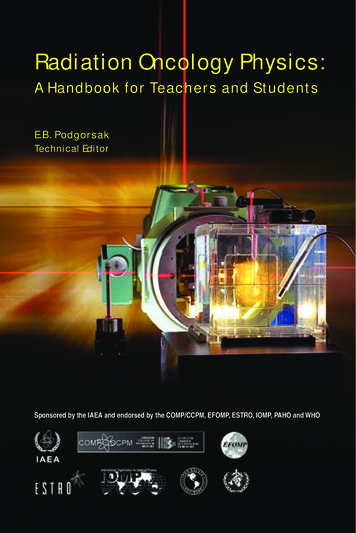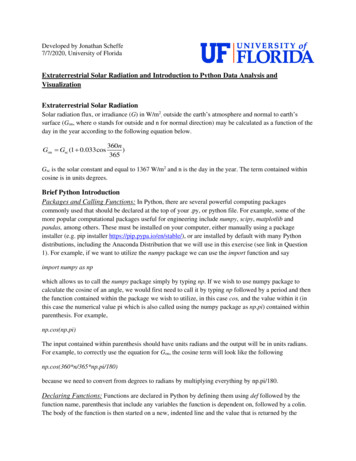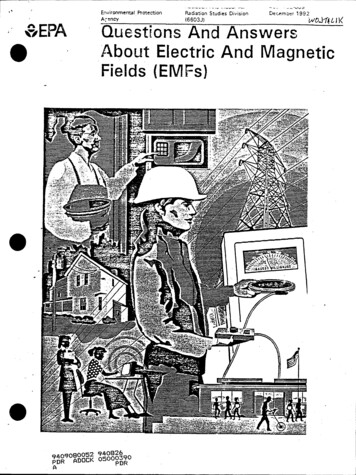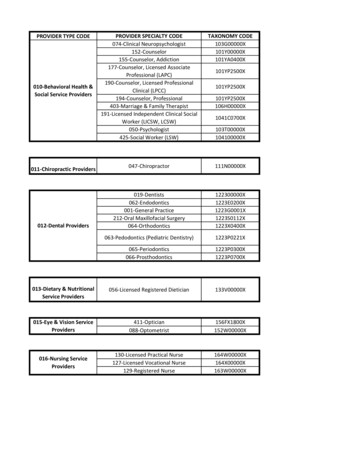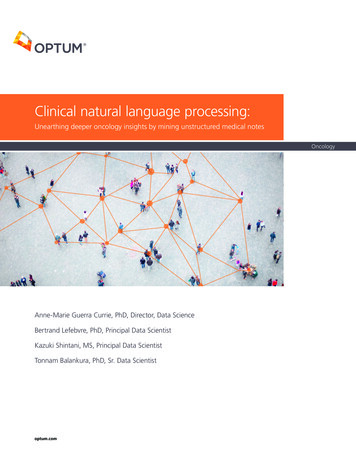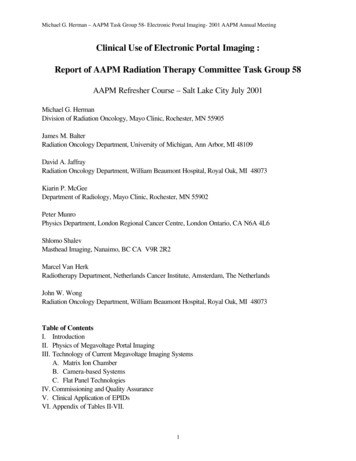
Transcription
R ADIATION ONCOLOGY
R ADIATION ONCOLOGY:A PHYSICIST’S-EYE VIEWMichael Goitein
Michael GoiteinHarvard Medical SchoolBoston MA, USAandAnkerstrasse 15210 WindischSwitzerlandWhile the advice and information in this book are believed to be true and accurateat the time of going to press, neither the author, editors, or publisher accepts any legalresponsibility for any errors or omissions that may be made. Neither the publishernor the author makes any warranty, express or implied, with respect to the materialcontained herein.Library of Congress Control Number: 2007932210ISBN 978-0-387-72644-1e-ISBN 978-0-387-72645-8Printed on acid-free paper. 2008 Springer Science Business Media, LLCAll rights reserved. This work may not be translated or copied in whole or in partwithout the written permission of the publisher (Springer Science Business Media,LLC, 233 Spring Street, New York, NY 10013, USA), except for brief excerpts inconnection with reviews or scholarly analysis. Use in connection with any form ofinformation storage and retrieval, electronic adaptation, computer software, or bysimilar or dissimilar methodology now known or hereafter developed is forbidden.The use in this publication of trade names, trademarks, service marks, and similarterms, even if they are not identified as such, is not to be taken as an expression ofopinion as to whether or not they are subject to proprietary rights.9 8 7 6 5 4 3 2 1springer.com
for Gudrun
PREFACEThis book describes how radiation is used in the treatment of cancer.It is written from a physicist’s perspective, describing the physicalbasis for radiation therapy, and does not address the medical rationaleor clinical aspects of such treatments. Although the physics ofradiation therapy is a technical subject, I have used, to the extentpossible, non-technical language. My intention is to give my readersan overview of the broad issues and to whet their appetite for moredetailed information, such as is available in textbooks.1I hope that this book will be interesting and helpful to radiationoncologists, to physicists, and to those who are curious about, but notyet engaged in, the field. I hope, too, that experienced practitionerscan get something out of this book. However, it is directed primarilytoward those just entering the field, and to those contemplatingentering it – either from the physics or the medical side. I have beenasked, “Will it help residents pass their board examinations?” I canmake no promises; it is certainly not a cook-book of answers. But Ithink it could help.I have avoided formulae and quantitation so far as has been possible.I think that there is a schism between the descriptive methods that areuseful in physics and those that are needed in medicine or biology.Physics is, to a large extent, a highly successful effort to explainphysical phenomena through mathematical formulae. It is quite astonishing, for example, how much that happens around us is describedby Maxwell’s four relatively simple equations. Such successes maysuggest to us that the formulae are a fundamental basis of the realitythey describe – not just phenomenologica l approximations to it. Itseems to me that physicists are so beguiled by the success of formulae1There are many excellent textbooks dealing with both medical physics andradiation oncology. Reading this book is in no way a substitute forstudying these. An excellent medical physics text is Johns andCunningham (1983). Unfortunately, this book, which went through fourvery successful editions, is no longer being updated. As a result, it nolonger covers the very latest developments in the field. There are anumber of more up-to-date textbooks, such as that by Khan (2003).vii
viiiPrefacein explaining much of the physical world that they are tempted to thinkthat the same approach will work in the world of medicine and biology.But, I think that an understanding of many important medical andbiological matters cannot be based on mathematical relationships, so Ihave avoided them where possible.I have generally shown schematic, rather than quantitatively accurate,figures, and have stated only approximate values of various quantitiesof interest. I have tried to appropriately qualify my figures andstatements within the text, but I would like to caution readers at theoutset that the data presented here should not be used as a basis forthe treatment of patients. Treatments must be based on measured, orat least confirmed, data appropriate to the local environment, whichare interpreted by qualified experts.I have concentrated my focus on radiation therapy using externalbeams of high energy X -rays and of protons. With regret, I have hadto neglect important techniques such as brachytherapy (the use ofradioactive materials either implanted or inserted into the patient) andelectron beam therapy, and I have not been able to address the severalspecialized forms of external beam x-ray therapy such as radiosurgery, gamma-knife therapy, robotic therapy and tomotherapy. In avery few instances, I have discussed matters which are not yet part ofmainstream practice. This is the case, for example, in my discussionsof: the calculation and display of the uncertainty bounds of dosedistributions; the use of Monte Carlo techniques to calculate dosedistributions; and the implementation of pencil beam scanning todeliver intensity-modulated proton therapy. I trust that these willsoon be routine.Lastly, I have not done justice to the huge literature of the subjects Ihave covered. I have pointed to some few articles which seem to meto be of interest, but I have omitted many others of equal or greatervalue. And, I confess, I have tended to cite my own publicationsdisproportionately since many of the issues I address in this bookhave been the focus of my own work and writings.Y ZMy wife, herself a radiation oncologist, was trained by a demandingand intellectually endowed man who asked a lot from his trainees andstaff. She tells me that, knowing that everyone makes errors fromtime to time, he told them that he could accept any mistake they madeso long as the one who had made the error knew why he or she had
Prefaceixdone what they had done. I hope this book will arm my readers tobetter know why they can or should do, or not do, certain things.Unfortunately, in establishing safe and reliable procedures for patienttreatments, medical physics has tended to suffer, in my opinion, froma certain cook-book attitude. But, for me, “Because we’ve alwaysdone it that way” is simply not an acceptable answer to the question“Why?”My complimentary intention is to encourage the asking of the question“Why not?” So often one hears a nascent idea being unthinkingly dismissed as impractical, unreasonable, or impossible. This usually happenswhen someone on one side of the physics/medicine partnership proposes something novel to someone on the other side. My wish is togive people on both sides of the divide a sufficient understanding ofthe knowledge and methodology of the other side that they will not beafraid to ask “Why not?” when their next brainwave is summarilyrejected. One should not give up on an idea until its critics can convincingly explain why it cannot or should not be done. It is partly my goalto encourage your questioning of everything in your discipline – and, notleast, of my own words.Almost all of us have, or will have, direct personal knowledge ofcancer. In the United States, roughly two out of five people will, onaverage, get cancer during their lifetime. This means that there is,on average, a 96% chance that, of the eight people nearest to youamongst your family and friends, at least one will develop a cancerduring his or her lifetime. So, cancer is important to all of us. And,radiation therapy is important to cancer – approximately half of allcancer patients will receive radiation as at least part of their therapy.It is therefore my hope that you may be motivated to look further intothe fascinating field of radiation therapy, if you are not already in it,and to have a better perspective on it, if you have already committedyourself to it.MICHAEL GOITEINWindisch, SwitzerlandJune 2007michael@goitein.ch
CONTENTS1.2.3.4.5.6.7.8.9.10.11.12.13.Preface . viiRadiation in the Treatment of Cancer . 1Uncertainty . 13Mapping Anatomy . 23Designing a Treatment Beam . 57Biology Matters . 85Designing a Treatment Plan . 111Motion Management . 139Planning Manually . 157IMRT and “Optimization” . 177Proton Therapy in Water . 211Proton Therapy in the Patient . 247Quality Assurance . 287Confidence . 289Afterword . 303Acknowledgements . 307Acronyms . 309References . 311Index . 323xi
1 There are many excellent textbooks dealing with both medical physics and number of more up-to-date textbooks, such as that by Khan (2003). or clinical aspects of such treatments. Although the physics of entering it – either from the physics or the medical side. I have been make no pr
